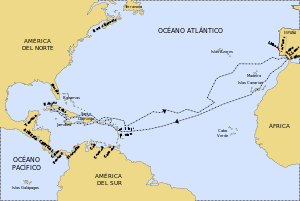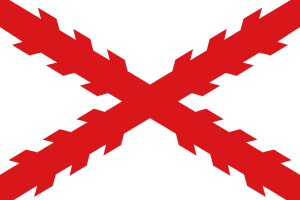Colony of Santiago
| Santiago | ||||||||||
| Spanish colony | ||||||||||
| ||||||||||
|
| ||||||||||
 | ||||||||||
| Capital | Villa de la Vega | |||||||||
| Languages | Spanish | |||||||||
| Political structure | Colony | |||||||||
| Governor | List of Governors of Santiago | |||||||||
| History | ||||||||||
| • | Established | 1509 | ||||||||
| • | Disestablished | 1655 | ||||||||
| Area | 10,991 km² (4,244 sq mi) | |||||||||
| Currency | Spanish dollar | |||||||||
| ||||||||||
Santiago was a Spanish colony of the Spanish West Indies and within the Viceroyalty of New Spain, in the Caribbean region. Its location is the present-day island and nation of Jamaica.
Pre-Columbian Jamaica
Around 650 AD, Jamaica was colonized by the people of the Ostionoid culture, who likely came from South America.[1] Alligator Pond in Manchester Parish and Little River in St. Ann Parish are among the earliest known sites of this Ostionoid people, who lived near the coast and extensively hunted turtles and fish.[1]
Around 950 AD, the people of the Meillacan culture settled on both the coast and the interior of Jamaica, either absorbing the Ostionoid people or co-inhabiting the island with them.[1]
The Taíno culture developed on Jamaica around 1200 AD.[1] They brought from South America a system of raising yuca known as "conuco."[2] To add nutrients to the soil, the Taíno burned local bushes and trees and heaped the ash into large mounds, into which they then planted yuca cuttings.[2] Most Taíno lived in large circular buildings (bohios), constructed with wooden poles, woven straw, and palm leaves. The Taino spoke an Arawakan language and did not have writing. Some of the words used by them, such as barbacoa ("barbecue"), hamaca ("hammock"), kanoa ("canoe"), tabaco ("tobacco"), yuca, batata ("sweet potato"), and juracán ("hurricane"), have been incorporated into Spanish and English.
Columbus


Christopher Columbus set sail on his second voyage to the Americas on September 24, 1493.[3] On November 3, 1493, he landed on an island that he named Dominica. On November 22, he landed on Hispaniola and spent some time exploring the interior of the island for gold. He left Hispaniola on April 24, 1494, and arrived at the island of Juana (Cuba) on April 30 and Jamaica on May 5. He explored the south coast of Juana before returning to Hispaniola on August 20. After staying for a time on the western end, present-day Haiti, he finally returned to Spain.
Columbus returned to Jamaica during his fourth voyage to the Americas. He had been sailing around the Caribbean nearly a year when a storm beached his ships in St. Ann's Bay, Jamaica, on June 25, 1503.
For a year Columbus and his men remained stranded on Jamaica. A Spaniard, Diego Mendez, and some natives paddled a canoe to get help from Hispaniola. The island's governor, Nicolás de Ovando y Cáceres, detested Columbus and obstructed all efforts to rescue him and his men. In the meantime, Columbus allegedly mesmerized the natives by correctly predicting a lunar eclipse for February 29, 1504, using the Ephemeris of the German astronomer Regiomontanus.[4] Help finally arrived, from the governor, on June 29, 1504, and Columbus and his men arrived in Sanlúcar de Barrameda, Castile, on November 7, 1504.
The Seville colony

The Spanish Empire began its official governance of Jamaica in 1509, with formal occupation of the island by conquistador Juan de Esquivel and his men. Esquivel had accompanied Columbus in his second trip to the Americas in 1493 and participated in the invasion of Hispaniola. A decade later, Friar Bartolomé de las Casas wrote Spanish authorities about Esquivel's conduct during the Higüey massacre of 1503.
The first Spanish settlement was founded in 1509 near St Ann's Bay and named Seville. In 1534 the settlers moved to a new, healthier site, which they named Villa de la Vega, which the English renamed Spanish Town when they conquered the island in 1655. This settlement served as the capital of both Spanish and English Jamaica from its foundation in 1534 until 1872, after which the capital was moved to Kingston.
The Spaniards enslaved many of the native people, overworking and harming them to the point that many had perished within fifty years of European arrival. Subsequently, the lack of indigenous opportunity for labor was mended with the arrival of African slaves.[5] Disappointed in the lack of gold on the isle, the Spanish mainly used Jamaica as a military base to supply colonizing efforts in the mainland Americas.[6]
The Spanish colonists did not bring women in the first expeditions and took Taíno women for their common-law wives, resulting in mestizo children.[7] Sexual violence with the Taíno women by the Spanish was also common.[8][9]
Although the Taino referred to the island as "Xaymaca," the Spanish gradually changed the name to "Jamaica."[10] In the so-called Admiral's map of 1507 the island was labeled as "Jamaiqua" and in Peter Martyr's work "Decades" of 1511, he referred to it as both "Jamaica" and "Jamica."[10]
English conquest
In late 1654, English leader Oliver Cromwell launched the Western Design armada against Spain's colonies in the Caribbean. In April 1655, General Robert Venables led the armada in an attack on Spain's fort at Santo Domingo, Hispaniola. However, the Spanish repulsed this poorly-executed attack, known as the Siege of Santo Domingo, and the English troops were soon decimated by disease. [11] [12][13]
Weakened by fever and looking for an easy victory following their defeat at Santo Domingo, the English force then sailed for Jamaica, the only Spanish West Indies island that did not have new defensive works. In May 1655, around 7,000 English soldiers landed near Jamaica's Spanish Town capital. The English invasion force soon overwhelmed the small number of Spanish troops (at the time, Jamaica's entire population only numbered around 2,500).[14]
In the following years, Spain repeatedly attempted to recapture Jamaica, and in response in 1657 the English Governor of Jamaica invited buccaneers to base themselves at Port Royal on Santiago, to help defend against Spanish attacks. Spain never recaptured Jamaica, losing the Battle of Ocho Rios in 1657 and the Battle of Rio Nuevo in 1658. For England, Jamaica was to be the "dagger pointed at the heart of the Spanish Empire", although in fact it was a possession of little economic value then.[13]
See also
General:
References
- 1 2 3 4 Atkinson, Lesley-Gail, The Earliest Inhabitants: The Dynamics of the Jamaican Taíno.
- 1 2 Rogozinski, Jan, A Brief History of the Caribbean.
- ↑ "Christopher Columbus - 2nd Voyage".
- ↑ Samuel Eliot Morison, Admiral of the Ocean Sea: A Life of Christopher Columbus, 1942, pp. 653–54. Samuel Eliot Morison, Christopher Columbus, Mariner, 1955, pp. 184–92.
- ↑ "JAMAICAN HISTORY I". Discover Jamaica. Retrieved 23 August 2013.
- ↑ "Brief History of Jamaica". Jamaicans.com. Retrieved 23 August 2013.
- ↑ Guitar, Lynne. "Criollos: The Birth of a Dynamic New Indo-Afro-European People and Culture on Hispaniola.". KACIKE: Journal of Caribbean Amerindian History and Anthropology. Archived from the original on 2 December 2008. Retrieved 27 May 2011.
- ↑ Léger 1907, p. 23.
- ↑ Accilien et al. 2003, p. 12.
- 1 2 Cundall, Frank, The Story of the Life of Columbus and the Discovery of Jamaica.
- ↑ Rodger 2005, p. 29.
- ↑ Rodger 2005, p. 24.
- 1 2 Coward 2002, p. 134.
- ↑
- Parker, Matthew (2011). The Sugar Barons.
